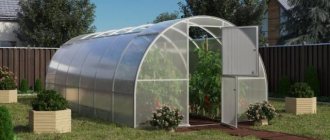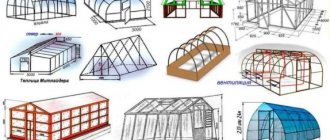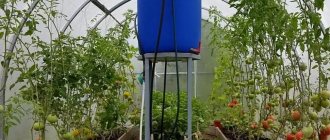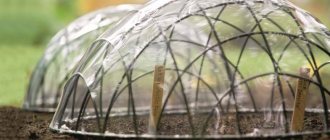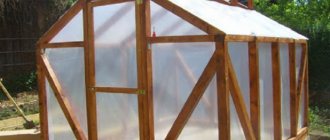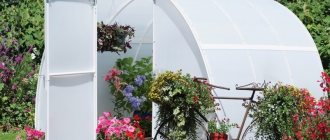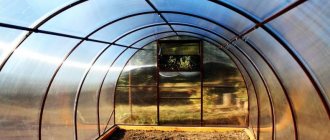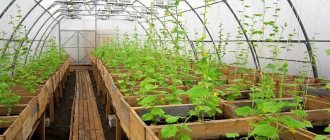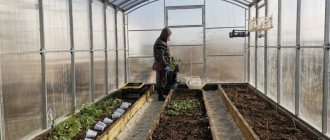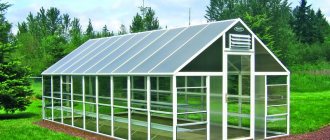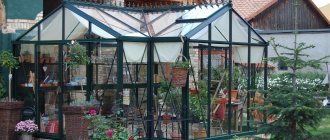When building or purchasing a greenhouse, a gardener wants the structure to last as long as possible. And this directly depends on the quality of the materials from which the structure is made, and how well they are protected from negative influences (corrosion, for example). At the moment, galvanized greenhouses are the most reliable and durable.
Galvanized greenhouses
Galvanized greenhouse frame
Assembly of a greenhouse from a galvanized profile
Advantages of a galvanized greenhouse
The material is used for assembling ceiling partitions and greenhouse complexes of various shapes. The finished design can be multifaceted, square or oval.
Its increased resistance to the negative effects of the external environment is the result of a chemical reaction. When interacting with air, a protective film is formed on the surface of the product.
The absence of pronounced traces of oxidation on metal parts is not the only advantage of structures of this type. The list of benefits is quite extensive and includes:
- Easy to install;
- Relatively light weight;
- Budget cost;
- Strength;
- Reliability;
- Attractive appearance.
When producing profiles, one of the following technologies is used: cold stamping, rolling.
Profile for the frame - which one to choose
After all, greenhouses are also divided into categories. Some are intended for seasonal use for seedlings, while others are for all-season growing of plants.
What a greenhouse - such a frame
In the first case, as a rule, polyethylene film is used to cover the greenhouse and the greenhouse frame is covered with it only before direct use. In other words, such a greenhouse is used for a relatively short time and is not subjected to varied loads.
Of course, such a greenhouse will not require a powerful frame capable of withstanding wind and snow loads.
Another thing is if you need to set up a greenhouse that will be used all year round, there is something to think about.
A durable coating requires a durable frame
Modern materials for covering greenhouses have a long service life. As a rule, it is 10 – 20 years. Of course, having such a covering material, every greenhouse owner wants to have a frame to match the durable material.
Therefore, all the attention of the owners is switched to the metal profile and pipes. To understand what is best to use for the frame of your greenhouse, you need to take a closer look at these materials.
Paint as protection
Frames made of painted pipes are available for sale. At first glance, this design inspires confidence.
Greenhouse frame coated with powder paint.
The cross-section of this structure indicates the strength of the future frame. But we are talking about a greenhouse that we are going to use all year round.
Is painted profile pipe durable?
Painted profile.
Let's imagine that we have a greenhouse with a frame made of a profile pipe and a polycarbonate covering.
- Using a polycarbonate coating and a frame made of a profile pipe, you have to increase the spans between the supporting frame; the profile pipe is quite expensive.
- As a result, the strength of the polycarbonate coating is greatly reduced; it can break under a slight snow load.
- If you reduce the spans, thereby increasing the number of frame elements, the cost of the greenhouse will increase significantly.
Features of powder painting
But that's not all.
- Many people have probably seen such a pipe for sale. The top is coated with powder paint.
- When offering this material, sellers focus on this coating, which is ultra-modern, durable, and reliable.
But we must understand that no matter what paint coating is, powder or regular, it is just a paint coating.
The slightest mechanical impact, during transportation, assembly, etc., and small paint chips appear on this frame; you may not even notice them at first.
Chips in paint coating.
What will happen in this case? Your greenhouse is doomed.
- After 1.5 - 2 years, the paint will begin to lose its appearance, rust will appear in places where it is chipped, and if a small stain is noticeable, then in fact the surface of the pipe affected by rust will be much larger.
- Ultimately, such a design will last no more than 4–5 years.
Badly? Yes, but that's not all.
- When purchasing such a frame, you should know that the protective coating on this material is only on the outside.
What about the inside? She is completely unprotected.
- In greenhouse conditions, where water vapor coexists with warm air, this is death for the frame in the shortest possible time. It was not for nothing that we predicted the service life of such a frame to be 4–5 years, this is at best.
Disadvantages of a galvanized greenhouse
The summer resident should take into account that:
- You will have to pay more for galvanized pipes than for material that is not coated;
- Galvanized profiles cannot be welded at home. To assemble the structure, special bolted connections will be required. The finished product is noticeably inferior in terms of reliability to elements that have been welded;
- The protective coating of the pipes may be damaged when bent. They are recommended to be used only for creating pitched structures.
The list of disadvantages is complemented by low load-bearing capacity. If the material is chosen incorrectly, the frame will be deformed.
A painted greenhouse is a reason for painting work
Painting has a number of weaknesses, namely: with significant daily temperature changes, the paint will inevitably lag behind the metal, since they have different coefficients of thermal expansion. The exposed metal surface will immediately begin to rust, and this will further accelerate the paint peeling off.
Painted frame
Over the course of a season or two, your new greenhouse will significantly lose its original appearance. Rust forms unsightly streaks on the surface of polycarbonate, which also reduce transparency. If you don't paint the greenhouse every year, it will eventually rust through.
If you have already purchased a painted greenhouse, do not despair. Your greenhouse is not necessarily doomed to destruction. Coat all metal parts with an anti-corrosion compound, preferably immediately upon purchase. Be especially careful about all ends, holes, and welds. Plugs should be placed at the ends of the profile pipe to prevent water from getting inside. The supporting structures should be regularly inspected and tinted, and then, with proper care, the painted greenhouse will last a long time.
Types of galvanized profiles for greenhouses
Possible options are presented in the following table:
| Profile type | Description |
| Profiled pipe | No seams, square or rectangular cross-section. High strength, quick fastening. Zinc is applied using a galvanic bath. |
| Hat (omega) | The cross-section resembles a Latin V. The demand for the material is due to the ease of processing and installation. |
| For drywall | Budget-friendly, easy to use. |
| Corner | It is characterized by an L-shaped cross-section, reduced strength, and low cost. |
Cold stamping is a method in which the impact on the raw material is limited by such an indicator as the recrystallization temperature. To prevent the occurrence of defects caused by a decrease in the level of ductility, lubricants are used.
The second method involves hot or cold rolling of carbon steel. The finished sheet is treated with zinc alloy. It can be applied to one or both sides of the future product. The profile, manufactured in full compliance with the requirements of GOST, is resistant to mechanical stress and the negative influence of external factors.
Important! You can do galvanizing yourself. This will require a special composition, which, for the convenience of the user, is produced in liquid and aerosol form.
Preliminary calculations for a galvanized greenhouse
The size of the structure is determined based on the approximate number of beds, botanical and biological characteristics of the crops that are planned to be planted. Particular attention should be paid to the type of future shelter. In most cases, it is made arched or gable.
Experienced gardeners choose a form based on indicators such as:
- Plant height;
- Size of the plot;
- Ease of use.
For low-growing crops, the space provided by an arched structure will be sufficient. Tall plants will require significantly more space. When planning their planting, you should give preference to a gable greenhouse.
The level of comfort of a summer resident largely depends on the details: the width of the paths, the height of the ceiling, space for storing scrap materials and the necessary equipment. These nuances need to be taken into account at the planning stage.
The parameters of a standard arched structure made of galvanized profiles and polycarbonate are listed in the following table:
| Greenhouse, m | length Width | 6*3 |
| Door, cm | Height Width | 85*80 |
| Lower support frame, cm Arcs, cm | section | 2,5*2,5*0,02 |
| Vents, cm Lintels, cm | section | 2,0*2,0*0,015 |
To build a greenhouse with your own hands, you will need 7 profile rods and 3 polycarbonate profiled sheets.
We work for you
is engaged in the production of frames for industrial (farm) and country greenhouses. Our designs are highly durable. From us you can order an inexpensive frame for greenhouses with a house and an arched version. The price of the structure depends on its configuration, size, and order volume. The final cost is announced after all details have been agreed upon.
Our clients have a 24-hour support service and consultations are provided at a high professional level completely free of charge. You can ask your question by phone or online.
To place an order on the website, use the special form. regularly organizes promotions and sales of goods at special prices. The “Sale” section contains all current offers. Before placing an order, you have the opportunity to read reviews from our customers.
Selecting material for constructing a greenhouse
The quality of galvanized profiles is determined based on the rolling line. Thanks to galvanizing, a protective layer is formed on the product. The profile should be free of dents, scratches and other defects.
When purchasing galvanized sheets and pipes, you must read the documents that accompany the product. The manufacturer marks the category in them. The technical specifications that may be provided are listed below:
| Class | Lead content (per 1 m2), g | Coating thickness, microns |
| P | 570-855 | 40-60 |
| 1 | 258-570 | 18-40 |
| 2 | 142-258 | 10-18 |
The seller’s refusal to inform the buyer is a significant reason to doubt the quality of the materials offered.
In any case - steel
Modern greenhouses designed for polycarbonate are made mainly from cold rolled steel of the following types:
- galvanized steel corner;
- open galvanized steel profile;
- galvanized steel profile pipe;
- painted steel profile;
- painted steel profile pipe.
Choosing a corner is definitely not recommended. Of these materials, this is the least durable and is intended mainly for lightweight greenhouses and film greenhouses.
Where to place the greenhouse on the site
Placing a greenhouse is a stage no less important than accurately calculating the parameters. Its effectiveness depends on where it is located.
The location where the structure will be installed must meet several criteria, including:
- Flat landscape (minimal slope is acceptable);
- Natural protection from the north wind;
- Competent orientation to the cardinal directions;
- Lack of shadow inside the greenhouse from objects located outside (shrubs, trees, buildings).
Also, we must not forget about the “wind rose”. Excessive airflow is a common cause of death of plants that are not adapted to rapid changes in temperature.
Back and front walls of the greenhouse
Let’s look at the option with a gable roof, since traditional dome structures are much more difficult to assemble, especially if a galvanized “omega” profile is used in the construction of the greenhouse, which is difficult to bend and will constantly break.
In order for the greenhouse structure to be level, you will need an area with a flat surface. If the back or front wall is assembled with a “screw,” it will be very difficult to straighten it later, and the polycarbonate will lie crooked.
So, we lay out a square or rectangle of profiles on the ground, where the lower and upper parts are the width of the future greenhouse, and the right and left parts are the height.
Important! Before attaching the profiles to each other, be sure to measure the size diagonally from one corner to the opposite.
The two dimensions between the corners must be completely identical or differ by no more than 5 mm. Thus, the result is a square, not a rhombus.
The profiles are inserted into each other and secured with self-tapping screws with pressure caps. Since galvanization is very soft, it does not need to be drilled; the self-tapping screw will make a hole for itself and reliably fasten the two segments together. At least two fasteners are placed at each corner, otherwise the structure will wobble and break.
As soon as the square is assembled, we find the middle of the upper segment and draw a perpendicular line upward from it. This will mark the ridge of the greenhouse roof. Using a tape measure, measure the size from the corner to the ridge and multiply it by two - this is the size of the profile that needs to be cut and cut the walls exactly in the middle. Thus, the profile is bent at the required angle and forms a gable roof.
We attach the roof to the square and get a finished rear wall, which remains to be further reinforced with stiffening ribs. They can stand either crosswise or diagonally. This significantly strengthens the structure and will not allow it to bend under the weight of snow and even a person.
The front wall is assembled in exactly the same way, with the only difference being that it is necessary to assemble the doorway and, accordingly, the door itself.
Advice! It is better to assemble the door frame along the opening. This will help avoid possible distortions and errors in dimensions.
Instructions for installing a galvanized greenhouse (step by step)
As an example, let's take a greenhouse made of polycarbonate and galvanized profiled sheets. The source data is listed in the table:
| Construction | length/height/width, m | 6*2,1*3 |
| Profile pipe | cross section, cm | 0,2*0,2 |
To achieve the desired result, you need:
- Check that all necessary tools and materials are available.
- Read the instructions.
- Assemble the arches using separate round-shaped parts. Secure them with nuts and screws.
- Attach racks.
- Provide anchorage to the ground.
- Assemble and attach horizontal beams.
- Install the bottom ties. Supplement them with arches with attached lugs.
- Install the middle ties. They should be located between the arches.
- Securely secure the top ties. The maximum interval is 1 m.
- Prepare material for sheathing.
- Protect cells from penetration of dirt and water using sealing tape.
- Form the windows and door. Sheathe and install them.
- Cover the finished frame with sheathing material. Reliable fastening is ensured using roofing screws or screws equipped with thermal washers.
The final stage is attaching the fittings. This includes latches, hooks and other necessary parts.
A greenhouse made of galvanized profile will last 20-30 years if the summer resident strictly follows the instructions provided and the advice of professionals during assembly. The quality of care for the erected structure is of great importance.
Gable version
Just looking at a photo of a greenhouse from a profile of this type, you can see obvious positive aspects, among which good rigidity comes to the fore.
But when creating a frame, it is worth correctly measuring the angles of inclination; if the manipulations are carried out according to the diagram, then the snow will fall to the ground itself, without creating a load on the supports. Unlike other forms, there is no need to bend the blanks, and since this is a rather complex and labor-intensive process, the creation time will be significantly reduced. Experts highlight the following disadvantages:
- Consumption of materials.
- Difficulties at work.
- Sheathing the roof is inconvenient.
The appearance can surprise any person with its beauty; even, clearly measured dimensions create confidence in the quality of the manipulations performed.

